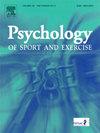避免重复错误:了解针对假头行动的错误后调整。
IF 3.1
2区 心理学
Q2 HOSPITALITY, LEISURE, SPORT & TOURISM
引用次数: 0
摘要
头部假动作是篮球运动中一种常见的欺骗性动作,能有效干扰对手并诱发失误。本研究调查了在不同的反应-刺激间隔(RSI)内,与头部假动作和相关动作线索有关的错误后行为调整和神经变化。参与者被要求对中心目标球员的传球方向做出反应,而忽略目标人物和侧翼球员的头部方向。结果显示,与侧翼球员(或头部)一致条件相比,侧翼球员(或头部)不一致条件下参与者的反应时间更长。结果还显示,被试在对动作提示做出错误反应后,反应速度变慢,这表明存在错误后反应变慢(PES)效应。而且,短 RSI 的 PES 效应大于长 RSI。事件相关电位(ERPs)的结果显示,与长RSI相比,参与者在短RSI下出错后表现出更大的错误相关负性(ERN)振幅,但错误正性(Pe)振幅较小。总之,这些研究结果表明,人们在对动作线索做出错误反应后会表现出错误后减速。此外,RSI 可能会影响出错后的反应速度以及早期错误处理和错误证据积累,因为出错后短时间内存在一个处理瓶颈。这些发现为运动策略和行为矫正提供了启示。本文章由计算机程序翻译,如有差异,请以英文原文为准。
Avoiding repetitive mistakes: Understanding post-error adjustment in response to head fake actions
Head fake is a common deceptive action in basketball that can effectively disrupt opponents and induce errors. This study investigated post-error behavioral adjustment and neural changes associated with head-fake action and related action cues across different response‒stimulus intervals (RSIs). Participants were asked to respond to the central target player's pass direction, ignoring the head direction of the target person and the flankers. The results revealed that the participants exhibited longer reaction times in the flanker (or head) incongruent condition compared to the flanker (or head) congruent condition. The results also revealed that the participants slowed their responses following an error in response to an action cue, indicating the presence of the post-error slowing (PES) effect. Moreover, the PES effect was greater at short RSI than at long RSI. The results of Event Related Potentials (ERPs) revealed that the participants exhibited a greater amplitude of error-related negativity (ERN) but a smaller amplitude of error positivity (Pe) following an error at a short RSI than at a long RSI. Collectively, these findings suggest that people can exhibit post-error slowing following an error response to action cues. Moreover, the RSI may affect the speed of response after an error and early error processing and erroneous evidence accumulation, as a processing bottleneck exists for a short time after an error. These findings offer insights into sports strategies and behavior modification.
求助全文
通过发布文献求助,成功后即可免费获取论文全文。
去求助
来源期刊
CiteScore
6.40
自引率
5.90%
发文量
172
审稿时长
69 days
期刊介绍:
Psychology of Sport and Exercise is an international forum for scholarly reports in the psychology of sport and exercise, broadly defined. The journal is open to the use of diverse methodological approaches. Manuscripts that will be considered for publication will present results from high quality empirical research, systematic reviews, meta-analyses, commentaries concerning already published PSE papers or topics of general interest for PSE readers, protocol papers for trials, and reports of professional practice (which will need to demonstrate academic rigour and go beyond mere description). The CONSORT guidelines consort-statement need to be followed for protocol papers for trials; authors should present a flow diagramme and attach with their cover letter the CONSORT checklist. For meta-analysis, the PRISMA prisma-statement guidelines should be followed; authors should present a flow diagramme and attach with their cover letter the PRISMA checklist. For systematic reviews it is recommended that the PRISMA guidelines are followed, although it is not compulsory. Authors interested in submitting replications of published studies need to contact the Editors-in-Chief before they start their replication. We are not interested in manuscripts that aim to test the psychometric properties of an existing scale from English to another language, unless new validation methods are used which address previously unanswered research questions.

 求助内容:
求助内容: 应助结果提醒方式:
应助结果提醒方式:


